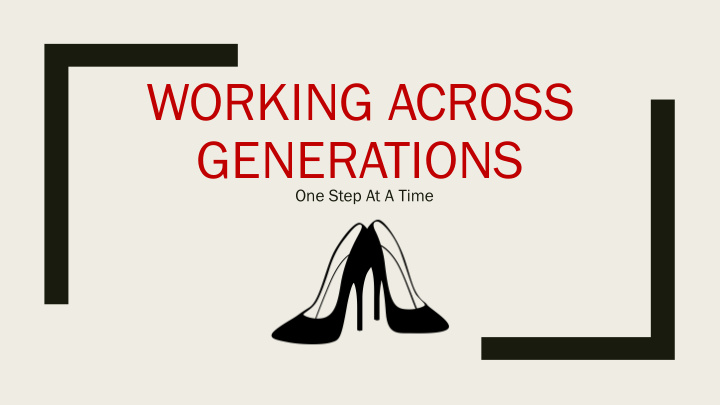



WORKING ACROSS GENERATIONS One Step At A Time
WHO ARE WE IN THE WORKPLACE? ■ Our history, and the influencers during our maturation plays a role in how we interact with each other in the workplace. ■ Today we have four generations that have to learn to work together. Plus Generation Z’rs are on their way. ■ Traditi tionli lists ts (Born between 1925 and 1946) ■ Baby B y Boo oomers rs (Born between 1946 and 1964) ■ Ge Generation X Xers rs (Born between 1965 and 1980) ■ Ge Generation Ys or M s or Millennials (born after 1980) ■ Ge Generation Z Z (Born after 1995)
TRADITIONALISTS (Born between 1925 and 1946) ■ Considered among the most loyal workers. ■ Highly dedicated and the most risk averse. Their values were shaped by the Great Depression, World War II, and the postwar boom years. ■ MAIN FORM OF COMMUNICATION = Writing a letter or note or face to face ■ Attitude Toward Career = Jobs are for life ■ Aspiration= Homeownership
BABY BOOMERS (Born between 1925 and 1946) ■ Boomers are the first generation to actively declare a higher priority for work over personal life. ■ They generally distrust authority and large systems. Their values were shaped primarily by a rise in civil rights activism, Viet Nam, and inflation. ■ MAIN FORM OF COMMUNICATION = Telephone ■ Attitude Toward Career = Careers are defined by employers ■ Aspiration= Job Security
GENERATION X (Born between 1965 and 1980) ■ Generation Xers naturally question authority figures and are responsible for creating the work/life balance concept. ■ Born in a time of declining population growth, this generation of workers possesses strong technical skills and is more independent than the prior generations. ■ MAIN FORM OF COMMUNICATION = Email and Text Message ■ Attitude Toward Career = Loyal to profession not employer ■ Aspiration = Work-Life Balance
GENERATION Y or Millennials (born after 1980) ■ This group is the first global-centric generation, having come of age during the rapid growth of the Internet and an increase in global terrorism. ■ They are among the most resilient in navigating change while deepening their appreciation for diversity and inclusion. ■ MAIN FORM OF COMMUNICATION = Text Message and Social Media ■ Attitude Toward Career = Work with not for organizations ■ Aspiration = Freedom and Flexibility
GENERATION Z (Born after 1995) ■ Part-time and interns (Waiting for them to fully enter into the workforce) ■ Dependent on technology and limited grasp of alternatives ■ MAIN FORM OF COMMUNICATION = Interactive, Real Time, Limited Network ■ Attitude Toward Career = Will move between types of organizations and businesses ■ Aspiration = Security and Stability
HOW DO WOMEN TREAT WOMEN? ■ A Wall Street Journal Study showed: ■ Only 53% of younger employees say they learn from older employees ■ Only 23% of employees under age 34 say they receive new ideas from older employees GENDER IS INFLUENCED BY THE GENERATION GAP ■ 70% of women say they were treated better by a male boss ■ Women over 50 said they prefer to mentor women in their 20s versus women in their 30s or 40s ■ Older women are more competitive for jobs (Tripping the Prom Queen – Prof. Barash) and younger women often feel entitled to mentorship by other women (Will You Be My Mentor? – Sheryl Sandberg)
Implicit Bias ■ What comes to mind when you see the people in the pictures?
CLAP or PAT
SMART OR NICE CLAP = BAD PAT = GOOD
SAFE OR SLOW CLAP = NICE PAT = SAFE
LAZY OR ARROGANT CLAP = LAZY PAT = LIAR
We have to learn to work together By the year 2022: Baby Boomers will make up 25.6% of the workforce Millennials will make up 46% of the workforce
Step by Step Guide CREATE TE DIVERSE ERSE TEAMS MS (F (Flat instead o of top d down wn)
Step by Step Guide UND UNDER ERSTAND ND IND NDIVIDUAL MOTI TIVATORS RS
Step by Step Guide STAGE GATHERI HERING NGS S (GRABBING C COFFEE OFFEE VS VS. C CONNE NECTIN ING O G ONLINE INE) )
Step by Step Guide CREATE N TE NEW LEARNI RNING WORK RKSH SHOPS S (Where everyone can be vulnerable and no one is the expert)
Step by Step Guide ENCOURA RAGE C E CONS NSTANT T FEEDBACK (In different forms. An in person meeting may not always be needed)
Step by Step Guide REVERSE M ERSE MENTORI RING NG (Millennials = Social Media? Baby Boomers = Soft Skills? )
Step by Step Guide RE RECOGNIZE DIF IFFERENCES S IN IN HO HOW WE WE RESPOND D TO CONFLICT CT BABY BOOMERS = TEAM CONSENSUS GEN X = RESOLVE IMMEDIATELY AND DIRECTLY MILLENIALS = CONFLICT MANAGEMENT TAUGHT IN SCHOOL
Step by Step Guide EMPO POWE WER S R SUCCES ESS LEVERAGE STRENGTHES GIVE FEEDBACK GIVE RECIGNITION
Step by Step Guide COMMU MMUNICA CATION TOOL B BOX ESTABLISH SEVERAL OPT OPTIONS FOR F OR FRE REE A AND QU QUICK COMMU OMMUNICATION (Email is Evil) WHAT KEEP EEPS EM EMPLOYEE EES (Lucky to have a job versus Job is lucky to have me) GIVE REC ECOGNITION AN AND GIVE E RES ESPEC ECT (Go out of your way to give recognition and show respect for each other’s work)
LET’S CONNECT Facebook: Letitia Clark Twitter: LetitiaCClark LinkedIn: Letitia Clark Instagram: LetitiaCClark 714.438.4605 lclark35@cccd.edu
Recommend
More recommend